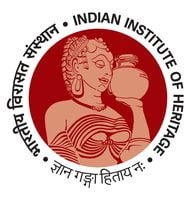This painting was commissioned by Raja Sansar Chand of the kingdom of Kangra. As the Kingdom of Kangra had expanded, so did it’s royal wealth. It is in the use of the riches that Sansar Chand accumulated which really made a mark. An insightful leader and an aesthete, Sansar Chand emerged as a great patron of art. He established numerous workshops, each dedicated to promotion of different arts and crafts. Most notable among them was the Kangra atelier of painting. These workshops produced several paintings which gained fame across India. The king was also a patron of architecture and built the fort at Tira Sujanpur (at present, Hamirpur district of Himachal Pradesh) outside Kangra with magnificent palaces, temples and gardens. Such was the greatness of Sansar Chand that he was commonly referred to as ‘Pahadi Badshah’ or Emperor of the hills.
Kangra style was on the pinnacle of its excellence in the reign of the King Sansar Chand. Miniature paintings of Kangra became the glory of Pahari painting which depicted verdant greenery with naturalistic, minute and intricate detailing. The depiction of flora is made noticeable by the use of multiple shades of green, which is the main feature of this style. Feminine figures with tenderly engraved features are depicted very gracefully in these paintings with soft and intricate facial features. The Kangra artists adopted various shades of colours made from minerals, vegetables etc. The opulence of the king's court can be seen through the medium of thin lines and colours. Also, the courtly life can be seen as reflecting the realm of the gods.
In this representation, Sansar Chand himself is seen in the durbar of gods standing in an attitude of humble submission with folded hands. The adoration can be viewed through a jewel studded multi-foliated arch; Rama and Sita are seated on a beautifully ornamented gilt throne under a green embroidered canopy. Blue complexioned Rama is shown wearing an elaborated plumed mukuta, a typical Pahari element. He has a halo over his head indicating his divine status. Sita, the epitome of beauty, holds a lotus in one hand which not only symbolizes Lord Vishnu but is also an attribute of Goddess Lakshmi, whose incarnation Sita is believed to be. A host of figures stand on either side. On the right side, Rama’s three brothers hold their respective attributes that mark out Rama’s kingship and the divine status of the deities; one holds aloft a bejewelled chhatra (parasol) that spreads over their heads, while the other two brothers hold a chauri (fly whisk), a quiver of arrows and a sheathed sword.
Blending myth and history, the poet Tulsidas stands on the left, the only one who has his name inscribed in the Devnagiri script over his head. Goswami Tulsidas was a Ramanandi Vaishnava saint and poet, famous for his devotion to the deity Rama. He wrote several recognized works in Sanskrit and Awadhi, but is best known as the author of the epic Ramcharitmanas, a retelling of the Sanskrit epic Ramayana based on the legend Rama's life in the vernacular Awadhi. The representation here belongs to the ‘Uttar Kand’ of the epic.
Saint Tulsidas stands with his hands raised in a gesture of singing, presumably a Chaupai, the expressions of his face suggesting his devout immersion in singing the hymns. The depiction of Saint Tulsidas here suggests that the artist has given him divine status since he was the author of the Ramacharitamanas.
Besides saint Tulsidas stands Hanuman, who is believed to be the greatest devotee of Shri Rama, shown offering a fruit as a symbol of his devotion. The figure of the patron-ruler is presumably shown for two reasons: firstly, to elevate their status, and secondly, to establish the lineage of the family, in this case as descendants of Rama. His figure is painted larger in comparison to any other figures represented here, emphasizing his position as a king and a patron. The multitude of other figures can be seen in the foreground praising the enthroned deities. Monkeys along with bear Nala, Sugreev (later king of Kishkindha) and saints, one of whom is prostrating before the divine couple, stand as testament to the influence of great devotion associated with this seventh incarnation of Vishnu. The delicacy of drawing and lyrical quality of lines is outstanding and draws on strong emotions.
There is much conscientious detailing in the work of architecture, adornments and draperies, also the rendering is accompanied by a certain slackening of energy in the drawing, along with the attempt to convey calmness in painting the facial features particularly prominent in the expressions of Sita, accompanied by a sumptuous use of gold. Such stylistic traits are characteristics of the early nineteenth century painting of Kangra.
Bibliography
Archer, W.G. Kangra Painting, London, 1952.
Randhawa, Mohinder Singh. Maharaja Sansar Chand: The Patron of Kangra Painting, New Delhi, 1970.



